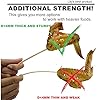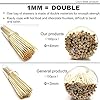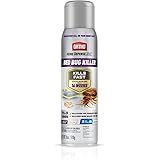GooingTop LED Grow Light,6000K Full Spectrum Clip Plant Growing Lamp with White Red LEDs for Indoor Plants,5-Level Dimmable,Auto On Off Timing 4 8 12Hrs
16% OffHOPELF 6" Natural Bamboo Skewers for BBQ,Appetiser,Fruit,Cocktail,Kabob,Chocolate Fountain,Grilling,Barbecue,Kitchen,Crafting and Party. Φ=4mm, More Size Choices 8"/10"/12"/14"/16"/30"(100 PCS)
28% OffHow to Banish Tiny Silver Bugs in Houseplant Soil
Noticing tiny silver bugs crawling around the soil of your houseplants? You’re not alone. These pesky insects, commonly called soil mites, can be a nuisance for indoor gardeners. Luckily, there are effective methods to get rid of them and keep them away for good.
This comprehensive guide covers everything you need to know about identifying, treating, and preventing silver bugs in your houseplant soil. With the right techniques, you can restore your plants to health and enjoy your indoor horticulture without annoying pests.
Identifying Tiny Silver Bugs on Houseplants
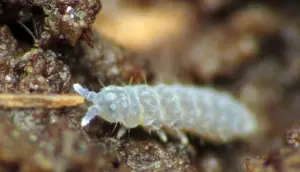
The first step is confirming that tiny silver bugs are indeed the culprits infesting the soil. Here are the key identifying traits of soil mites:
- Tiny size – Adults reach 1/50 to 1/20 inches long. They appear as very specks.
- Silvery or transparent – Their bodies often reflect light, appearing shiny silver, white, or clear.
- Fast moving – They move quickly through soil and coverings. Speed helps distinguish them from fungus gnats.
- Webbing – Some species spin fine webs in the soil, unlike most other houseplant pests.
- Lack of wings – Unlike fungus gnats, silver mites do not have wings and cannot fly. They crawl and jump.
Use a magnifying glass to inspect the bugs and match these descriptors. Confirming soil mites are present allows targeting them correctly.
Common Types of Soil Mites
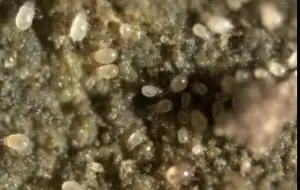
While dozens of mite species may inhabit soils, a few commonly infest houseplants:
Grain Mites
- Feed on mold and fungi in damp soils
- 0.5 mm size, white to transparent
- Fast reproduction cycle
Bulb Mites
- Attracted to decomposing plant matter
- Pinhead size, shiny silver appearance
- Most damage in flowering bulbs
Predatory Mites
- Hunt other mites for food
- Red to orange coloring, very small
- Considered beneficial insects
Tarsonemid Mites
- Microscopic mites, smaller than 0.25 mm
- Translucent white coloring blends into the soil
- Eat fungi and organic debris
Different species have preferences for factors like moisture, food sources, and population density. Identifying the type can help tailor treatment. But in most cases, general soil mite control methods will work.
Understanding Soil Mite Behavior
To get rid of silver bugs, you need to understand their behavior patterns:
- Reproduce rapidly in damp, organic soil environments.
- Feast on decaying plant roots, leaf litter, fungi, and algae.
- Dislike light and dry conditions. Seek out dark, humid spots.
- Usually stays in the top 2-3 inches of soil, rarely appearing above.
- Spread easily via contact, jumping, or wind gusts between plants.
- Most active in warmer temperatures 70°F – 80°F.
Controlling the environment by lowering moisture, removing food sources, and drying out soil deprives mites of ideal habitat. Combined with miticide treatments, this curbs infestations.
Dangers of Soil Mites to Houseplants
While tiny, soil mites can cause disproportionate damage:
- Feed on plant roots and bulbs – Damages or kills young and vulnerable plants.
- Spread fungal diseases – Mites carry pathogens like powdery mildew between plants.
- Annoy homeowners – Large populations crawling up from the soil are a nuisance.
- Indicate overly damp conditions – Excess watering often precedes mite problems.
- Prevent germination – They attack newly planted seeds and seedlings.
Fortunately for hobbyists, infestations usually don’t kill mature plants. But treating mites before populations explode prevents wider damage.
Causes and Risk Factors for Soil Mites
What allows mites to thrive indoors? Several cultural and environmental factors:
- Overwatering – Excessive moisture allows mite eggs and populations to bloom. They need humidity.
- Poor drainage – Densely packed, slow-draining soil retains moisture mites need.
- Organic matter – Decaying plant material is an excellent mite food source.
- Old potting mix – Stale, nutrition-depleted soil invites mites to break down organic matter.
- Low light – Shaded areas under dense foliage provide the dark, damp habitat mites seek.
- Infested plants – Bringing in new plants spreads mites to existing pots nearby.
- Warm temperatures – Heat between 70°F – 90°F accelerates mite reproduction and activity.
correcting these root causes deprives mites of ideal conditions and limits further spread.
Inspecting and Preventing Mite Spread
To assess the extent of infestation:
- Check all plants with signs of mites – Look for tiny silver specks crawling on the soil surface and under rims.
- Isolate suspect plants – Keep them separated from the main collection to prevent spread.
- Monitor weekly – Especially after watering, continue inspecting for reappearing mites.
- Sterilize tools – Disinfect shears, trowels, and pots between uses on different plants.
Early intervention when mites first appear is critical to curb populations before they explode. Quarantining gives time to treat plants before reintroducing.
Safely Getting Rid of Soil Mites on Houseplants
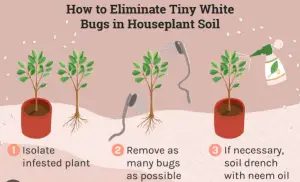
Once mites are detected, implement control measures promptly:
Remove the Top Inch of Soil
Discarding just the top layer deprives mites of food and shelter. Replace with fresh, sterile potting mix.
Report in Fresh Soil
For severe cases, fully repotting provides a clean slate free of mites. Discard all old soil.
Reduce Watering Frequency
Letting the soil dry out between waterings helps eliminate mites reliant on dampness.
Increase Light Exposure
Place plants in bright, direct light. This dries out moisture and drives away light-averse mites.
Apply Insecticidal Soap
Spraying a 2% soap solution directly into the soil kills mites on contact without residue.
Use Horticultural Oil
Applying a light dormant oil spray suffocates mites while being safe for plants.
Apply Chemical Miticide
Products with pyrethrins or bifenazate kill mites on contact when mixed with watering.
Introduce Predatory Mites
Beneficial mites like hypnosis feast on pest mites without harming plants.
Combining cultural changes to the environment with pesticide applications provides a one-two punch to rid plants of soil mites.
Step-by-Step Guide to Eliminating Soil Mites
Follow this systematic process to treat soil mites:
- Confirm mite presence using a 10x magnifying glass. Inspect soil surface and under pot rim.
- Isolate-infested plants away from the main collection.
- Repot plant in fresh sterile soil, discarding all old mix.
- Spray the plant thoroughly with insecticidal soap or horticultural oil. Target soil.
- Allow the plant to fully dry out before the next watering.
- Apply chemical miticide like bidentate as a soil drench.
- Repeat miticide application per label instructions (usually every 3-7 days).
- Maintain dry soil conditions between waterings.
- Keep the plant isolated for 4-6 weeks and monitor for recurring mites.
- Sterilize any tools used on infested plants before other uses.
With this systematic treatment plan, you can eliminate current mite populations and prevent future infestations. Be vigilant and take action at the first sign of mites before they spread.
Products for Treating Soil Mites
Here are effective products for getting rid of soil mites available on Amazon:
| Product | Key Ingredients | Application |
|---|---|---|
| Safer Brand Insect Killing Soap | Potassium salts of fatty acids | Spray directly into the soil |
| Bonide All Seasons Horticultural Oil | Mineral oil | Drench soil to suffocate mites |
| Summit Responsible Solutions Bifenazate Miticide | Bifenazate 0.98% | Soil drenched around roots |
| Arbico Organics Hypoaspis Predatory Mites | Live hyopaspis mites | Sprinkle on soil to devour pests |
Always carefully follow label directions when applying pesticides or introducing predatory mites. Combining methods yields the best mite control results.
Preventing Future Soil Mite Infestations
After eliminating current mites, take these steps to prevent reinfestations:
- Allow soil to dry out between waterings. Avoid excessive moisture.
- Provide plenty of light. Keep plants out of dark, damp corners.
- Replenish soil nutrients annually by top dressing or repotting.
- Sterilize pots before reuse with diluted bleach solution.
- Inspect new plants extremely closely before introducing them. Quarantine if concerned.
- Keep indoor humidity under 60% to deter mite populations.
- Treat immediately any signs of mites before they multiply.
With diligent cultural care and prompt treatment, if detected, you can keep soil mites controlled and enjoy pest-free houseplants.
Troubleshooting Soil Mite Issues
Refer to this troubleshooting guide if mites persist after treatment:
| Problem | Potential Cause | Solution |
|---|---|---|
| Mites return soon after treatment | Did not fully eliminate eggs/larvae | Repeat treatment targeting all life stages |
| Mites spread to other plants | Failed to isolate and contain initial infestation | Sterilize tools and pots to prevent the spread |
| Treatments ineffective | Used the wrong product or application method | Switch to a different class of pesticide |
| Plant decline continues | Root damage from prolonged infestation | May need to discard severely infected plant |
| Tiny white specks on the soil surface | Likely sap-feeding spider mites, not soil mites | Use miticides targeted for spider mites |
Catching infestations early and fully eliminating all mite life stages is key to successful treatment. Seek help from plant experts if problems persist.
When to Seek Professional Help
In most cases, hobbyists can resolve soil mite issues with diligent at-home treatment. But contact greenhouse professionals if:
- Mite populations explode into the thousands.
- Multiple treatment attempts fail to curb the infestation.
- Mites spread rampantly to most of your plant collection.
- Valuable or rare specimens are threatened.
- You want to identify the exact mite species.
Commercial miticides and fumigation may better control severe mite infestations. Professionals can also analyze soil samples.
Conclusion
Tiny silver bugs crawling over houseplant soil are annoying but treatable. Confirm the fast-moving mites and correct excess moisture and humidity. Combining repotting, predatory mites, pesticides, and cultural changes combats infestations. With preventative care, early intervention, and persistence, soil mites can be banished for good. No gardener should tolerate these pesky pests disrupting the enjoyment of their plants!









